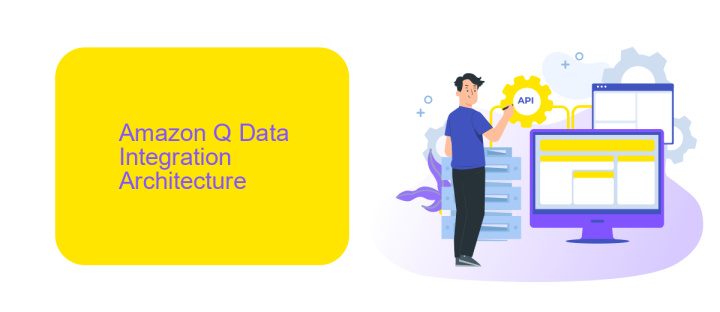Amazon Q Data Integration in AWS Glue
Amazon Q Data Integration in AWS Glue is a powerful solution designed to streamline data processing and transformation. By leveraging AWS Glue's serverless architecture, users can efficiently manage, prepare, and integrate data from various sources. This article explores the key features, benefits, and practical applications of Amazon Q Data Integration, demonstrating how it enhances data workflows within the AWS ecosystem.
Introduction
Amazon Q Data Integration in AWS Glue is a powerful solution that enables seamless data processing and transformation within the AWS ecosystem. AWS Glue is a fully managed ETL (Extract, Transform, Load) service that simplifies the process of preparing and loading data for analytics. By leveraging AWS Glue, organizations can efficiently handle large volumes of data, making it easier to derive valuable insights.
- Automated data discovery and cataloging
- Serverless architecture for scalability
- Integration with various AWS services
- Support for multiple data sources and formats
To further enhance data integration capabilities, tools like ApiX-Drive can be utilized. ApiX-Drive offers seamless integration with AWS Glue, allowing users to connect various applications and automate data workflows effortlessly. This ensures that data is always up-to-date and readily available for analysis, ultimately driving better business decisions.
Amazon Q Data Integration Architecture

Amazon Q Data Integration in AWS Glue leverages a robust architecture designed to streamline the process of data integration and transformation. At its core, AWS Glue acts as a fully managed ETL (Extract, Transform, Load) service, allowing seamless data preparation and integration from various sources. The architecture involves three primary components: the Glue Data Catalog, Glue Crawlers, and Glue Jobs. The Data Catalog serves as a central metadata repository, enabling efficient data discovery and management. Glue Crawlers automatically scan data sources to infer schemas and populate the Data Catalog, while Glue Jobs execute the ETL processes, transforming raw data into structured formats ready for analysis.
To further enhance the data integration process, services like ApiX-Drive can be integrated with AWS Glue. ApiX-Drive provides a user-friendly interface for setting up and managing integrations between different data sources and destinations. By automating data flows and reducing manual intervention, ApiX-Drive complements AWS Glue’s capabilities, ensuring a more efficient and reliable data pipeline. This combination of AWS Glue’s powerful ETL framework and ApiX-Drive’s seamless integration tools creates a comprehensive solution for managing complex data environments.
Data Preparation, Transformation, and Enrichment

Data preparation, transformation, and enrichment are critical steps in utilizing Amazon Q Data Integration in AWS Glue. Properly managing these stages ensures seamless data flow and optimized performance for your data analytics and machine learning tasks.
- Data Preparation: This involves cleaning and structuring raw data from multiple sources. Use AWS Glue to catalog and organize your datasets, ensuring consistency and accessibility.
- Data Transformation: Transform your data into a suitable format for analysis. AWS Glue provides built-in transformations and allows you to write custom ETL scripts to convert data formats, aggregate information, and apply business logic.
- Data Enrichment: Enhance your data by integrating additional information. Services like ApiX-Drive can automate the integration of third-party data sources, providing a richer dataset for more accurate insights.
By following these steps, you can ensure that your data is clean, well-structured, and enriched with valuable information. Leveraging tools like AWS Glue and ApiX-Drive will streamline your data integration process, enabling more effective data analysis and decision-making.
Data Pipeline for Continuous Data Integration

Implementing a robust data pipeline for continuous data integration is essential for maintaining data accuracy and timeliness in AWS Glue. The process begins with identifying the data sources and defining the data flow architecture to ensure seamless data ingestion and transformation.
Once the architecture is established, AWS Glue can be configured to automate the ETL (Extract, Transform, Load) processes. This involves setting up crawlers to catalog the data and creating Glue jobs to perform necessary transformations. Leveraging services like ApiX-Drive can further streamline the integration by automating data transfers between various applications and AWS Glue.
- Identify and catalog data sources using AWS Glue crawlers.
- Create and schedule Glue jobs for automated data transformation.
- Utilize ApiX-Drive for seamless data transfer and integration.
- Monitor and manage the data pipeline to ensure continuous data flow.
By implementing these steps, organizations can ensure that their data pipeline remains efficient and scalable, enabling real-time data integration and analytics. Continuous monitoring and optimization of the data pipeline are crucial for adapting to evolving data requirements and maintaining high performance.
Best Practices for Amazon Q Data Integration
When integrating Amazon Q Data with AWS Glue, it is crucial to follow best practices to ensure seamless and efficient data processing. Firstly, always define clear data schemas and maintain consistent data formats across all datasets. This helps in avoiding data inconsistencies and errors during the ETL (Extract, Transform, Load) process. Additionally, make use of AWS Glue's built-in transformations and apply them judiciously to clean and enrich your data before loading it into your target data store. Regularly monitor and optimize your AWS Glue jobs to improve performance and reduce costs.
Another best practice is to leverage integration services like ApiX-Drive, which can automate data transfers and streamline the integration process. ApiX-Drive supports a wide range of data sources and destinations, making it easier to connect Amazon Q Data with various applications. By using such services, you can reduce manual intervention, minimize errors, and ensure timely data updates. Always keep your integration services and AWS Glue configurations up-to-date to take advantage of new features and security enhancements.
FAQ
What is AWS Glue?
How does Amazon Q integrate with AWS Glue?
What are the benefits of using AWS Glue for data integration?
Can I automate data integration between Amazon Q and AWS Glue?
What are the common challenges in integrating Amazon Q with AWS Glue?
Time is the most valuable resource for business today. Almost half of it is wasted on routine tasks. Your employees are constantly forced to perform monotonous tasks that are difficult to classify as important and specialized. You can leave everything as it is by hiring additional employees, or you can automate most of the business processes using the ApiX-Drive online connector to get rid of unnecessary time and money expenses once and for all. The choice is yours!

